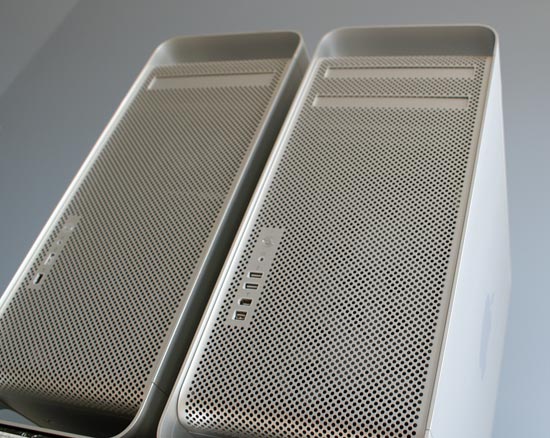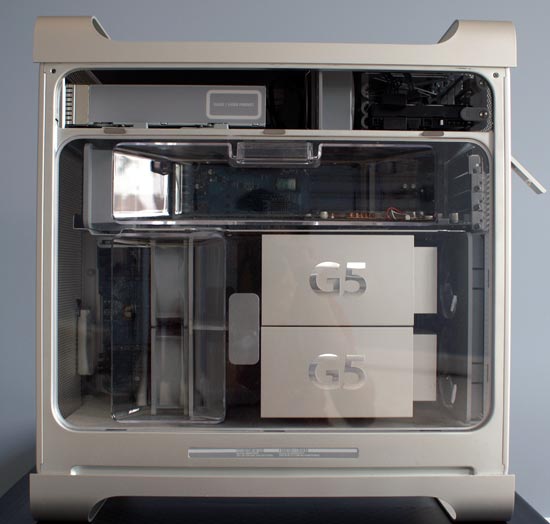Apple Mac mini Review (Mid 2010)
by Anand Lal Shimpi on August 9, 2010 3:37 AM ESTThe 2010 Mac mini vs. the 2005 Power Mac G5
The Apple IIe was the first Apple I ever owned, and the Power Mac G5 was the first Mac I ever owned. While not my original Power Mac, I do still have an early 2005 model with a pair of 2.5GHz PowerPC 970FX processors, 4GB of DDR-400 memory and an ATI Radeon 9600 Pro video card (AGP 8X of course). Brand new, this system cost $2699 (not including the memory upgrade). Today you can find slower G5s on eBay or Craigslist for around $400, and faster dual dual-core models going for as much as $800. That’s an amazing resale value for a five year old computer based on a seven year old platform.
Like all PowerPC Macs, the G5 won’t run anything newer than OS X 10.5 (Leopard). I stopped using the G5 during 10.4 (Tiger) and hadn’t tried anything newer, until now.

Power Mac G5 (left) vs. Mac Pro (right)
I was curious to see where the performance of a high end G5 fit in today’s Mac lineup. The PowerPC 970FX, a 90nm version of the original 970, was a very impressive architecture. Unlike the Pentium 4, the 970 was a very shallow (9 stage integer pipe) and wide microprocessor (5-way instruction dispatch). Running at up to 2.7GHz, there was enough IPC on the table for the Power Mac G5 to at least remain competitive with the Core 2 Duo in the new Mac mini.
I popped in a 600GB VelociRaptor and was quickly reminded that I was using a 5 year old machine. Despite being a SATA drive, the G5 was very unhappy with the new VelociRaptor. I couldn’t get Leopard to install to the drive without errors. I went back to something more 2005: a 150GB Raptor.
This time around Leopard installed just fine. I updated the OS to 10.5.8 and went about installing applications. While many modern OS X applications are now Intel-only, there are a surprising number that will run on PowerPC systems. Adobe Photoshop CS4 and Apple’s Aperture 2, both OS X benchmark favorites of mine, fully support the Power Mac G5. They installed without a hitch.

I tried to level the playing field as much as reasonably possible. I ripped out all but 2GB of memory from the G5 system, but left the 3.5” HDD in place. Most G5s would probably have a slower spinning, but potentially faster overall drive by now. And there’s no reason to assume that a G5 owner would have a 2.5” 5400RPM laptop drive in their system so that’s just going to have to be an inherent advantage over the mini.
The OS differences are obvious as well. Leopard is the best the G5 will run, while Snow Leopard comes standard with the 2010 Mac mini. Snow Leopard is faster so that’s another mini advantage.
This isn’t the most fair comparison, but it does give you an idea of how much of an upgrade you’d see as a G5 user if you wanted to replace your aging machine with the most affordable Mac:
| Mac mini vs. Power Mac G5 | ||||||||
| Adobe Photoshop CS4 | Aperture 2 | Cinebench R10 (Single threaded) | Cinebench R10 (Multithreaded) | Quicktime Encode | ||||
| Apple Mac mini (Mid 2010) - Core 2 Duo 2.40GHz | 60.7 seconds | 1.78 photos per second | 2727 | 5021 | 54.6 fps | |||
| Apple Power Mac G5 (Early 2005) - PowerPC 970FX 2.5GHz x 2 | 54.8 seconds | 1.82 photos per second | 1871 | 3395 | 23.7 fps | |||
Photoshop performance surprised me. If both systems were outfitted with 2GB of memory, the dual 2.5GHz G5 was 11% faster than the Mac mini. Moving to 4GB however opened up a bottleneck for the mini’s 2.40GHz Core 2 Duo (42.1 seconds) while memory size didn’t seem to have any impact on the G5 indicating that the system is CPU bound at this point.
My Aperture import test is a lot closer since we are more I/O bound. The G5 system only holds a 2% advantage over the 2010 Mac mini but it is at least competitive.
Cinebench and Quicktime video encoding are two areas where the mini really pulls ahead. A lot of this is going to boil down to what you can do with a good amount of compiler and software optimization, but given that all applications going forward are targeted at x86 architectures on the Mac I’d say that these results are valid and representative of at least a good portion of OS X applications.
Both single and multithreaded performance is around 47% faster on the Mac mini in Cinebench. The Quicktime encoding frame rates are double, but part of that is due to the difference in applications - Quicktime X is Snow Leopard only, while Leopard ships with Quicktime 7.
With performance varying from similar to significantly worse than the 2010 Mac mini, the real advantage the newer Macs have over the older G5 is power consumption:
| Mac mini vs. Power Mac G5 | ||||||||
| Idle | Load | |||||||
| Apple Mac mini (Mid 2010) - Core 2 Duo 2.40GHz | 8W | 30W | ||||||
| Apple Power Mac G5 (Early 2005) - PowerPC 970FX 2.5GHz x 2 | 132W | 261W | ||||||
At idle the Mac mini draws 8 watts. The dual Power Mac G5? 132 watts. Under load the gap shrinks to only 8.7x - 261W for the Power Mac vs. 30W for the Mac mini. It’s not a fair comparison since the two systems were built five years apart and targeted at different markets, but it does put things in perspective.
While the move from a G5 to a Mac mini might not always turn out to be a huge increase in performance, you’ll at least see a tremendous drop in power consumption.
The pair of 90nm PowerPC 970FX CPUs also needed a lot more to cool. As a result, while our Mac mini measured 42.5dB(A) just 1.5” from the chassis (in a 40 dB(A) room), the Power Mac G5 ranged between 51 and 66 dB(A) depending on how fast the fans were spinning.
As soon as I tweeted that I was installing Leopard on an old G5, AT reader bacalou responding asking if I’d post some of my experiences. I’d say overall I was surprised by how well Leopard ran on the Power Mac. While the machine is 5 years old, it was very quick for its time, not to mention that most modern Macs focus on energy efficiency rather than balls out performance.
Leopard is snappy on the machine, particularly after a clean install. I had problems with the Radeon 9600 Pro and/or ATI’s drivers causing video corruption, but it was fairly limited (I’d get a corrupt box behind my mouse cursor at times).
Application performance was also surprisingly good. Photoshop was quick and honestly, other than the noise I couldn’t really tell that I was using a PowerPC Mac.
The bigger problems I’d say are application and hardware compatibility. Steam and Starcraft 2 won’t work on PowerPC and that’s the trend going forward. A few years ago maintaining backwards compatibility was key, but these days PowerPC Macs are all but forgotten.
Would I toss Leopard on an aging Power Mac G5? Probably. Although selling the thing and using the money towards more modern, power efficient hardware is probably a better bet.










93 Comments
View All Comments
Guspaz - Monday, August 9, 2010 - link
Ever since the "Intel HD" integrated graphics (the ones that are on-package for certain i3/5/7 models) came out, Intel has had passable integrated graphics. They perform on-par with the GeForce 9400M (which was benchmarked in this review). That's not saying much, but it's an enormous improvement over the previous generation of GMA. That 9400M as benchmarked, though, is from a year ago (mid 2009), so I can't argue that Intel has caught up enough with nVidia to be a viable alternative for Apple. If they keep up the current momentum, though, they'll probably catch up with nVidia soon enough.From a more anecdotal perspective, I recently bought a Toshiba Portégé r700 (Anandtech recently discussed it in their "under 14" article) which (for my model) features a Core i5 520M. The graphics are Intel's on-package.
Performance is acceptable. StarCraft 2 is playable at native resolution with a perfectly smooth framerate, but this is admittedly at low to low-medium settings. That's more than I expected to get out of it, though; I didn't buy this thing for gaming, so anything at all is a bonus.
thunng8 - Tuesday, August 10, 2010 - link
9400M graphics was first released October 2008, not mid 2009. Also, the Integrated graphics used in the i3 mobile is clocked significantly lower than the i5 desktop. Only on the i5 that the Intel integrated graphics almost matches the 2008 9400M.Stuka87 - Monday, August 9, 2010 - link
I would have loved to see how it compared to the previous Mac Mini's with the intel graphics and such.And like some others have asked, will it run Starcraft 2? I typically play on my PC, but would be nice to not have to switch some times (Since saved games are saved on b.net).
archer75 - Monday, August 9, 2010 - link
I'm curious to know how World of Warcraft performs at 1900x1200 with all in game settings maxed?icecreampop3 - Monday, August 9, 2010 - link
At 1280x1024, maxed, 23fps according to notebookcheck.net. I'd say maybe 18 fps @ 1080p.archer75 - Monday, August 9, 2010 - link
I just looked up some youtube videos of wow running on the mini at 1920x1080, slightly lower than my resolution of 1920x1200 but they were getting 18-25fps in cities and warsong. So not that great.james.jwb - Monday, August 9, 2010 - link
Not only a WOW player, but you want a Mac Mini?You must be one tough SOB to admit to this ;)
tipoo - Monday, August 9, 2010 - link
I'm really confounded by the price jump over the previous generation. If it had stayed the same, I may have found the Mini to be worth it.mados123 - Monday, August 9, 2010 - link
A better alternative for an HTPC would be the Viewsonic VOT550 w/ Blu-ray, Core 2 Duo 2,2GHz, 4GB, etc. for around $600.http://www.viewsonic.com/vot530-550
Claudius-07 - Monday, August 9, 2010 - link
Just got an Acer Revo and installed XBMC. I have a seagate T+, HDX 1000, WD Live, and the Revo+XBMC is the best thing thus far (however can't bitstream HD audio). Anyhow, love Apple but still scratching my head on this one for the price.